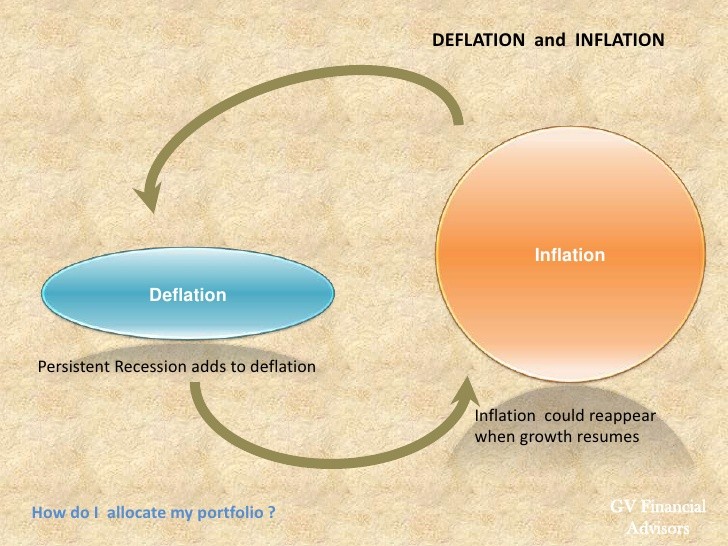Protect Your Portfolio Against Inflation And Deflation
Post on: 2 Июль, 2015 No Comment

Inflation and deflation are economic factors that investors must take into consideration when planning and managing their investments. Inflation is the term used to describe the rate at which prices for goods and services is rising. Deflation is the term used to describe a general decline in prices. Inflation and deflation are opposite sides of the same coin. When one trend is clearly in motion, the steps investors can take to protect their portfolios are clear. When inflation and deflation are both threatening at the same time, the proper steps to take are a bit more difficult to discern.
Inflation: What to Do
Over time, prices for everything from a loaf of bread to a new car tend to rise. When those increases become excessive, consumers and investors can face difficulties because their purchasing power will be falling rapidly. (Read What You Should Know About Inflation for insight into out how inflation relates to your investment portfolio.)
A clear example of inflation can be seen in the United States in the early 1970s. The decade began with inflation in the mid-single digits. By 1974, it had risen to more than 12%. It peaked at more than 13% in 1979. With investors earning mid-single digit returns on stocks, and inflation coming in at double that number, making money in the market was a tough proposition.
When it comes to protecting your portfolio from the ravages of inflation, there are several popular strategies. First and foremost is the stock market. Rising prices tend to be good news for equities. For fixed-income investors seeking an income stream that keeps pace with rising prices, Treasury Inflation-Protected Securities are a common choice. These government-issued bonds come with a guarantee that their par value will rise with inflation, as measured by the Consumer Price Index, while their interest rate will remain fixed. Interest on TIPS is paid semiannually. TIPS can be purchased directly from the government through the Treasury Direct system in $100 increments with a minimum investment of $100 and are available with 5-, 10-, and 20-year maturities. (For a few more tips on TIPS, read Treasury Inflation Protected Securities and Inflation-Protected Securities — The Missing Link .)
International bonds also provide a way to generate income. They provide diversification too, giving investors access to countries that may not be experiencing inflation. Gold is another popular inflation hedge, as it tends to retain or increase its value during inflationary periods. Other commodities can also fit in this bucket, as can real estate, since these investments tend to rise in value when inflation is on an upswing. On the commodities side, emerging-market countries often generate significant revenues from commodity exports, so adding stocks from these countries to your portfolio is another way to play the commodities card. (To learn more about inflation, read Coping With Inflation Risk .)
Deflation: What to Do
Deflation is a less common occurrence than inflation. It appears when a lower level of demand in the economy leads to an excessive drop in prices. Periods of high unemployment and economic depression often coincide with deflation.
Japan’s lost decade — the period between 1991 and 2001 — highlights the ravages of deflation. It began with collapses in both the stock market and the real estate market. Economic collapse resulted in falling wages. Falling wages led to a decrease in demand, which led to lower prices. Lower prices led to the expectation that prices would continue to decline, so consumer held off on making purchases. Lack of demand caused prices to fall further and the downward spiral continued. Combine that with interest rates that hovered near zero and a depreciating yen, and it lead to economic expansion coming to a screeching halt.
When deflation is a threat, investors go defensive by favoring bonds. High-quality bonds tend to fare better than stocks during periods of deflation, which bodes well for the popularity of government-issued bonds. Foreign bonds are also an option.
On the stock side, companies that produce consumer goods that people must buy no matter what (think toilet paper, food, healthcare) tend to hold up better than other companies; these are referred to as defensive stocks. Dividend-paying stocks are another consideration in the equity space. Cash also becomes a more popular holding. Certificates of deposit and plain old savings accounts are often a fit in this category.

Just as in during inflationary periods, there are a variety of methods by which you can construct your portfolio. Building it security by security is always an option. Investing in mutual funds or exchange-traded funds provides a convenient strategy if you don’t have the time, skills or patience to conduct security-level analysis. (To learn more, read Deflationary Shocks: Helping Or Hurting The Economy? and The Upside Of Deflation for some historical perspective.)
Caught in the Middle?
Sometimes it’s hard to tell whether inflation or deflation is the bigger threat. When you can’t tell what to do, plan for both. A diversified portfolio that includes allocation to investments that fare well during inflations periods and investments that fare well during deflationary periods can provide a measure of protection regardless of what happens in the economy.
Diversification is the key when you don’t have the desire to attempt to properly time the inflation/deflation cycle. Blue-chip companies tend to have the strength to weather deflation and also pay dividends, which help when inflation rises to the point where valuations stagnate.
Diversifying abroad is another strategy, as emerging markets are often exporters of in-demand commodities (a hedge against inflation) and not perfectly linked with the domestic economy (protection against deflation). High-quality bonds and TIPS are reasonable choices on the fixed-income side. With TIPs, you are guaranteed to at least get value of your original investment back.
Time horizon plays an important role too. If you have twenty years to invest, you probably have time weather a downturn of any variety. If you are close to retirement or living off of the income generated by your portfolio, you have not have the time to wait for a recovery and have little choice but to take immediate action to adjust your portfolio. (For more, check out Hedge Your Bets With Inflation-Linked Bonds and Curbing The Effects Of Inflation . )














